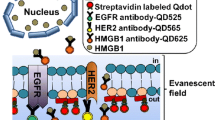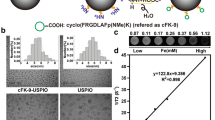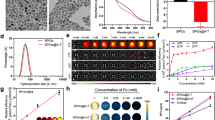Abstract
Purpose
The development of early, accurate diagnostic strategies for triple-negative breast cancer (TNBC) remains a significant challenge. Intercellular adhesion molecule-1 (ICAM-1) overexpressed in human TNBC cells is a potential molecular target and biomarker for diagnosis. In this study, small-molecule probe (denoted as γ3-Cy5.5) constructed with a short 17-mer linear peptide (γ3) and near-infrared fluorescence (NIRF) dye cyanine 5.5 (Cy5.5) was used to detect the expression of ICAM-1 in vitro and in vivo, and to diagnose TNBC via NIRF imaging.
Procedures
Western blotting and flow cytometric analysis were used for the detection of ICAM-1 expression in MDA-MB-231 and MCF-7 cells. The cytotoxicity of the small-molecule probe γ3-Cy5.5 was detected using the CCK8 assay. The in vitro targeting of the small-molecule probe γ3-Cy5.5 was verified via flow cytometry and a laser scanning confocal microscope. Finally, the targeting of small-molecule probe in vivo and ex vivo was observed by NIRF imaging.
Results
Western blotting and flow cytometry demonstrate that ICAM-1 was highly expressed in the MDA-MB-231 TNBC cell line. Laser confocal microscopy and flow cytometry results show that TNBC cells have an increased cellular uptake of γ3-Cy5.5 compared to the control probe γ3S-Cy5.5. With in vivo NIRF, a significantly higher Cy5.5 signal appeared in the tumors of mice administered γ3-Cy5.5 than those treated with γ3S-Cy5.5. The target-to-background ratio observed on the NIRF images was significantly higher in the γ3-Cy5.5 group (10.2, 13.6) compared with the γ3S-Cy5.5 group (4.4, 4.0) at 1 and 2 h, respectively.
Conclusions
This is the first report of the use of ICAM-1-specific small-molecule probe for in vivo NIRF optical imaging of TNBC. This method provides a noninvasive and specific strategy for the early diagnosis of TNBC.



Similar content being viewed by others
References
Bray F, Ferlay J, Soerjomataram I et al (2018) Global Cancer Statistics 2018: GLOBOCAN estimates of incidence and mortality worldwide for 36 cancers in 185 countries. Ca-Cancer J Clin. https://doi.org/10.3322/caac.21492
Foulkes WD, Smith IE, Reisfilho JS (2010) Triple-negative breast cancer. Wien Med Wochenschr 160:174–181
Carey L, Winer E, Viale G, Cameron D, Gianni L (2010) Triple-negative breast cancer: disease entity or title of convenience? Nat Rev Clin Oncol 7:683–692
Morris GJ, Naidu S, Topham AK et al (2010) Differences in breast carcinoma characteristics in newly diagnosed African-American and Caucasian patients: a single-institution compilation compared with the National Cancer Institute’s Surveillance, Epidemiology, and End Results database. Cancer 110:876–884
Dent R, Trudeau M, Pritchard KI et al (2018) Triple-negative breast cancer: clinical features and patterns of recurrence. Clin Cancer Res 13:4429–4434
Guo P, Huang J, Wang L, Jia D, Yang J, Dillon DA, Zurakowski D, Mao H, Moses MA, Auguste DT (2014) ICAM-1 as a molecular target for triple negative breast cancer. Proc Natl Acad Sci U S A 111:14710–14715
Sørlie T (2004) Molecular portraits of breast cancer: tumour subtypes as distinct disease entities. Eur J Cancer 40:2667–2675
Shah SP, Roth A, Goya R, Oloumi A, Ha G, Zhao Y, Turashvili G, Ding J, Tse K, Haffari G, Bashashati A, Prentice LM, Khattra J, Burleigh A, Yap D, Bernard V, McPherson A, Shumansky K, Crisan A, Giuliany R, Heravi-Moussavi A, Rosner J, Lai D, Birol I, Varhol R, Tam A, Dhalla N, Zeng T, Ma K, Chan SK, Griffith M, Moradian A, Cheng SWG, Morin GB, Watson P, Gelmon K, Chia S, Chin SF, Curtis C, Rueda OM, Pharoah PD, Damaraju S, Mackey J, Hoon K, Harkins T, Tadigotla V, Sigaroudinia M, Gascard P, Tlsty T, Costello JF, Meyer IM, Eaves CJ, Wasserman WW, Jones S, Huntsman D, Hirst M, Caldas C, Marra MA, Aparicio S (2012) The clonal and mutational evolution spectrum of primary triple negative breast cancers. Nature 486:395–399
Hellebust A, Richardskortum R (2012) Advances in molecular imaging: targeted optical contrast agents for cancer diagnostics. Nanomedicine 7:429–445
Chen X (2011) Integrin targeted imaging and therapy. Theranostics 1:28–29
Cheng D, Liang B (2015) Intercellular adhesion molecule-1 (ICAM-1) polymorphisms and cancer risk: a meta-analysis. Iran J Public Health 44:615–624
Hua S (2013) Targeting sites of inflammation: intercellular adhesion molecule-1 as a target for novel inflammatory therapies. Front Pharmacol 4:127
Dymicka-Piekarska V, Kemona H (2009) Does colorectal cancer clinical advancement affect adhesion molecules (sP-selectin, sE-selectin and ICAM-1) concentration? Thromb Res 124:80–83
Hayes SH, Seigel GM (2009) Immunoreactivity of ICAM-1 in human tumors, metastases and normal tissues. Int J Clin Exp Pathol 2:553–560
Schröder C, Witzel I, Müller V, Krenkel S, Wirtz RM, Jänicke F, Schumacher U, Milde-Langosch K (2011) Prognostic value of intercellular adhesion molecule (ICAM)-1 expression in breast cancer. J Cancer Res Clin Oncol 137:1193–1201
Rosette C, Roth RB, Oeth P, Braun A, Kammerer S, Ekblom J, Denissenko MF (2005) Role of ICAM1 in invasion of human breast cancer cells. Carcinogenesis 26:943–950
Liu L, Sun M, Song D, Wang Z (2013) The genetic polymorphisms of intercellular cell adhesion molecules and breast cancer susceptibility: a meta-analysis. Mol Biol Rep 40:1855–1860
Garnacho C, Serrano D, Muro S (2012) A fibrinogen-derived peptide provides intercellular adhesion molecule-1-specific targeting and intraendothelial transport of polymer nanocarriers in human cell cultures and mice. J Pharmacol Exp Ther 340:638–647
Altieri DC, Duperray A, Plescia J, Thornton GB, Languino LR (1995) Structural recognition of a novel fibrinogen gamma chain sequence (117-133) by intercellular adhesion molecule-1 mediates leukocyte-endothelium interaction. J Biol Chem 270:696–699
Chen C, Diao D, Liang G et al (2012) All-trans-retinoic acid modulates ICAM-1 N-glycan composition by influencing GnT-III levels and inhibits cell adhesion and trans-endothelial migration. PLoS One 7:e52975
Jiménez D, Rodanavarro P, Springer TA et al (2005) Contribution of N-linked glycans to the conformation and function of intercellular adhesion molecules (ICAMs). J Biol Chem 280:5854–5861
Maryelise C, Jingjing T, Yu JL et al (2013) Targeted delivery of proapoptotic peptides to tumor-associated macrophages improves survival. Pnas 110:15919–15924
Li J, Zhang Q, Pang Z, Wang Y, Liu Q, Guo L, Jiang X (2012) Identification of peptide sequences that target to the brain using in vivo phage display. Amino Acids 42:2373–2381
Hamann FM, Brehm R, Pauli J et al (2011) Controlled modulation of serum protein binding and biodistribution of asymmetric cyanine dyes by variation of the number of sulfonate groups. Mol Imaging 10:258–269
Zhang KE, Shujian GE, Lin X et al (2016) Intercellular adhesion molecule 1 is a sensitive and diagnostically useful immunohistochemical marker of papillary thyroid cancer (PTC) and of PTC-like nuclear alterations in Hashimoto’s thyroiditis. Oncol Lett 11:1722–1730
Zhu XW, Gong JP (2013) Expression and role of icam-1 in the occurrence and development of hepatocellular carcinoma. Asian Pac J Cancer Prev 14:1579–1583
Kotteas EA, Boulas P, Gkiozos I, Tsagkouli S, Tsoukalas G, Syrigos KN (2014) The intercellular cell adhesion molecule-1 (icam-1) in lung cancer: implications for disease progression and prognosis. Anticancer Res 34:4665–4672
Löfblom J, Feldwisch J, Tolmachev V, Carlsson J, Ståhl S, Frejd FY (2010) Affibody molecules: engineered proteins for therapeutic, diagnostic and biotechnological applications. FEBS Lett 584:2670–2680
Majumdar S, Siahaan TJ (2012) Peptide-mediated targeted drug delivery. Med Res Rev 32:637–658
Ardeshirpour Y, Chernomordik V, Capala J, Hassan M, Zielinsky R, Griffiths G, Achilefu S, Smith P, Gandjbakhche A (2011) Using in-vivo fluorescence imaging in personalized cancer diagnostics and therapy, an image and treat paradigm. Technol Cancer Res Treat 10:549–560
You L, Wang X, Guo Z, Zhang D, Zhang P, Li J, Su X, Pan W, Zhang X (2018) MicroSPECT imaging of triple negative breast cancer cell tumor xenografted in athymic mice with radioiodinated anti-ICAM-1 monoclonal antibody. Appl Radiat Isot 139:20–25
Funding
This study received financial support from the National Key Basic Research Program of China (973 Program), China (2014CB744504).
Author information
Authors and Affiliations
Corresponding author
Ethics declarations
Conflict of Interest
The authors declare that they have no conflict of interest.
Additional information
Publisher’s note
Springer Nature remains neutral with regard to jurisdictional claims in published maps and institutional affiliations.
Rights and permissions
About this article
Cite this article
Zhang, Y., Wang, M., Liu, W. et al. Optical Imaging of Triple-Negative Breast Cancer Cells in Xenograft Athymic Mice Using an ICAM-1-Targeting Small-Molecule Probe. Mol Imaging Biol 21, 835–841 (2019). https://doi.org/10.1007/s11307-018-01312-3
Published:
Issue Date:
DOI: https://doi.org/10.1007/s11307-018-01312-3




